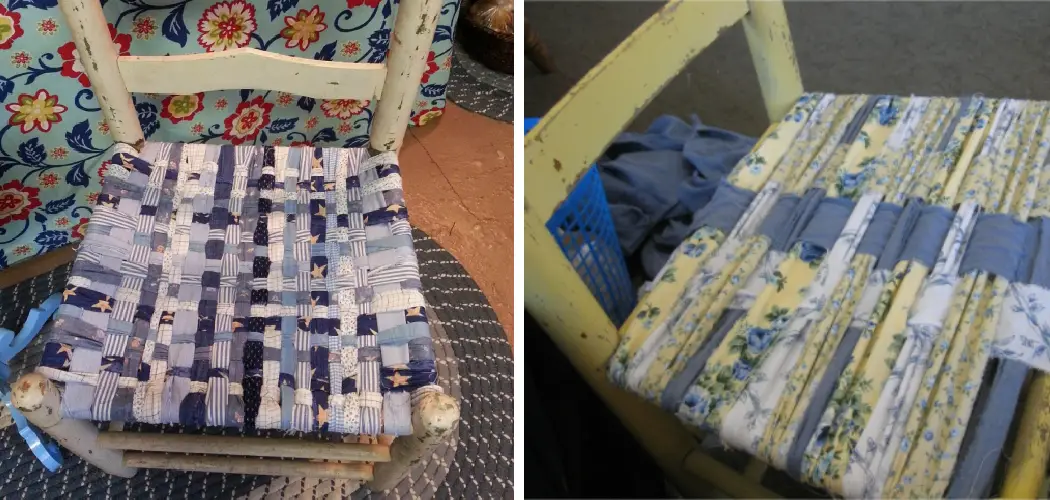Welcome to the world of DIY home décor! If you’re looking for a project that combines creativity, craftsmanship, and a touch of nostalgia, look no further than weaving a chair seat with fabric strips.
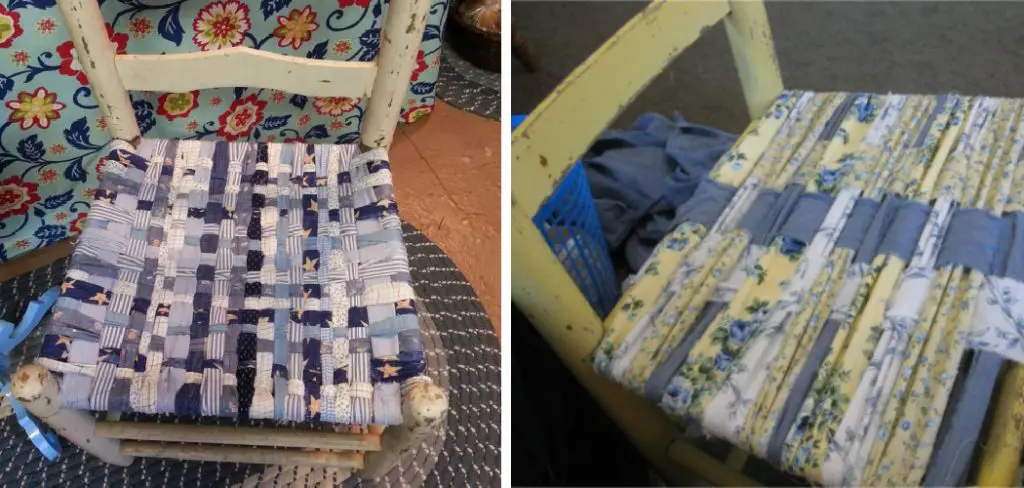
Chair seat fabric strips are a great way to add a unique touch to any chair, whether it’s an antique or a simple wooden one. Not only is it inexpensive, but it also allows for endless possibilities regarding design and color choices.
Whether you have an old, worn-out chair in desperate need of a makeover or simply want to add a unique and personalized touch to a new piece of furniture, this blog post is here to guide you through how to weave a chair seat fabric strips. Get ready to unleash your inner artist and create a stunning chair seat.
What Will You Need?
- A chair with a removable seat
- Fabric strips (1-2 inches wide and 6-8 inches long)
- Scissors
- Pliers
Once you have gathered all your materials, it’s time to get started!
9 Easy Steps on How to Weave a Chair Seat Fabric Strips
Step 1: Remove the Seat from the Chair
Before you can begin to weave, you must remove the seat from the chair frame first. This step is crucial as it makes working on the heart easier, ensuring you have a smooth surface to weave on. Depending on the type of chair, you may need to use a screwdriver or other tools to remove the seat.
Be careful not to damage the chair or the seat during this process. Once you have successfully removed the heart, you’ll be ready to start your weaving project.
Step 2: Prepare the Fabric Strips
Next, you need to prepare your fabric strips. Take the fabric you have chosen and cut it into strips. Each strip should be 1-2 inches wide and 6-8 inches long, but you can adjust the size depending on the design you want to create.
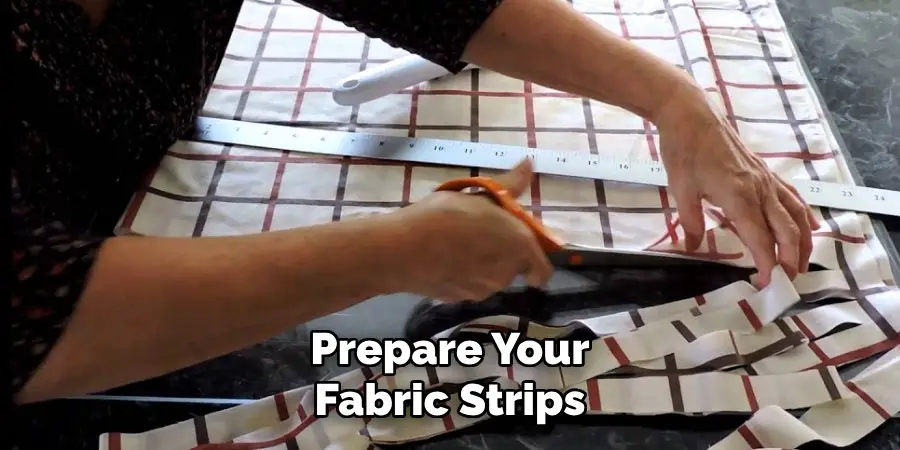
Remember, the longer the strips, the less you will need, but it might also make the weaving process a bit more challenging. Once all the strips are ready, you can move on to the weaving process.
Step 3: Start the Weaving Process
Starting from the corner of the chair seat, take a fabric strip and weave it through the existing seat material (if there is any). Keep one end of the strip longer than the other to secure it in place. Make sure the strip is pulled tight to the seat. Maintaining tension is crucial, as this will ensure your weave is sturdy and durable.
Suppose your chair seat is bare, simply securely the strip onto the frame. Continue with this process, alternating above and below each existing strip. If you’re starting on a bare frame, follow a simple over-and-under pattern. As you add more strips, you’ll start to see the distinctive woven pattern emerge.
Step 4: Weave Perpendicular Strips
Now, it’s time to start weaving in the opposite direction. Weave another fabric strip perpendicular to the initial strips, following the over-under pattern. This step will create the classic woven seat design. Always remember to pull the fabric strip tightly to ensure a secure weave. Continue this process, adding more strips and alternating the weaving direction until the entire chair seat is covered.
Step 5: Secure the Weaved Strips
Once you’ve covered the entire seat with woven fabric strips, it’s time to secure them. This step is crucial to ensure your weave doesn’t unravel over time. Starting from the first strip you weaved, take the end of the strip and secure it to the underside of the chair seat.
You can do this by tying it off or using a staple gun for a more secure hold. Repeat this process for each strip, ensuring they’re all tightly secured. Once all the strips are secured, your woven chair seat is nearly complete.
Step 6: Trim the Excess Fabric
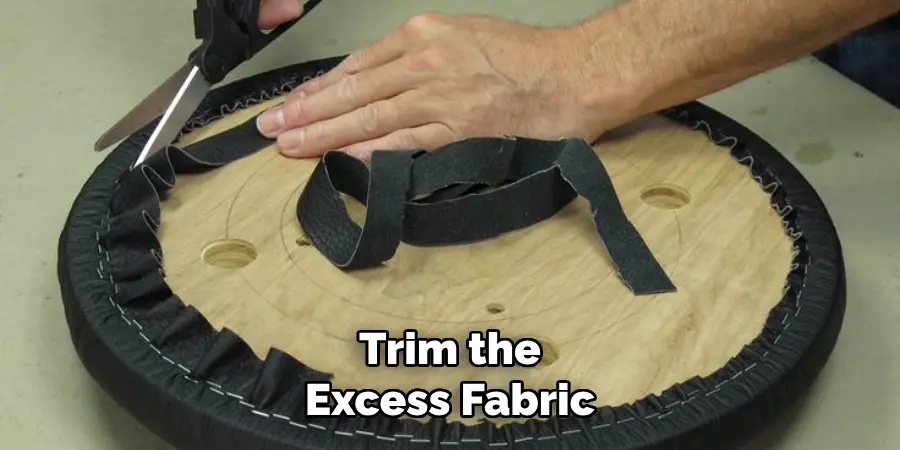
After securing all the weaved fabric strips, you might notice some excess fabric sticking out from the edges of the chair seat. This is normal and can be easily fixed. Carefully, using your scissors, trim the excess fabric close to where you secured the strips. Be mindful not to cut into the weaved pattern or the secured ends. This step will give your chair seat a clean, finished look.
Step 7: Reattach the Seat to the Chair
Now that your chair seat has been beautifully woven with fabric strips, it’s time to reattach it to the chair frame. Carefully align the seat back onto the chair frame, ensuring it fits securely. Depending on the type of chair, you may need to screw the seat back in place or simply slide it into the frame.
Make sure the seat is firmly secured; it should not wobble or shift when you sit on it. With the seat reattached, your DIY project is complete! You now have a stunning, uniquely designed chair that will be a conversation starter.
Step 8: Enjoy Your Handcrafted, Weaved Chair Seat
Congratulations on completing your DIY weaving a chair seat with fabric strips! Now, it’s time to enjoy the fruits of your labor. Place the chair in your favorite spot, admire the intricate weave pattern you’ve created, and experience the satisfaction of revitalizing an ordinary chair into a unique piece of art. Remember, with creativity and patience, you can transform any furniture into a stunning expression of your style.
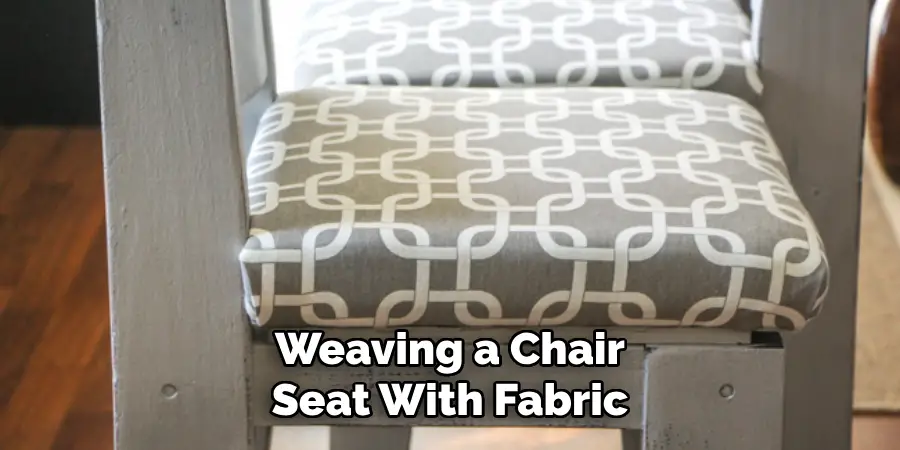
Step 9: Maintenance and Care
Now that you have put so much effort and creativity into reviving your chair, it’s essential to know how to maintain its beauty. Over time, the fabric can accumulate dust and dirt, so occasional cleaning is necessary. Use a vacuum cleaner with a brush attachment to gently remove dust from the weave.
If any stains occur, gently blot them with a damp cloth and a mild fabric cleaner. Avoid using harsh chemicals that may discolor or damage the fabric. When not in use, keep the chair dry away from direct sunlight to prevent the fabric strips from fading.
With proper care, your beautifully woven chair will continue to serve as a functional piece of art in your home for many years.
5 Additional Tips and Tricks
- Select the Suitable Fabric: When weaving a chair seat, the fabric strip’s quality can significantly impact the final result. Opt for durable materials like canvas or heavy-duty cotton, which can withstand wear and tear.
- Maintain Fabric Tension: Consistency is crucial in weaving. Ensure the fabric strips remain tight and evenly tensioned throughout the weaving process to achieve a uniform and neat appearance.
- Start From the Venter: Begin weaving from the middle of the chair seat and work your way towards the edges. This method helps to keep the weave symmetrical and balanced.
- Use a Suitable Weaving Pattern: Various weaving patterns, such as the basket weave or herringbone. Choose one that complements the design of the chair.
- Care and Maintenance: Once you’ve woven your chair seat, clean it gently to avoid damaging the fabric strips. A mild soap and water solution is usually sufficient for most fabric materials.

Following these tips and tricks, you can create a beautiful and sturdy chair seat using fabric strips. Experiment with different patterns and fabrics to personalize your unique creation.
5 Things You Should Avoid
- Avoid Using Thin Fabric Strips: Thin fabric strips may not provide the durability required for a chair seat. They are susceptible to tear easily and don’t respond well to frequent use.
- Avoid Uneven Tension: Uneven tension can result in a malformed chair seat. Always ensure the fabric strips are evenly tensioned for a neat, uniform weave.
- Avoid Rushing the Process: Weaving a chair seat requires patience. Rushing can lead to mistakes in the pattern and uneven weaving.
- Avoid Using Unsuitable Fabric Materials: Fabrics that are too stretchy, too thin, or lack durability should not be used. They may not withstand the weight and pressure exerted on the chair seat.
- Avoid Excessive Dampness When Cleaning: While keeping your woven chair seat clean is necessary, too much water can damage the fabric. Always use a damp cloth and mild soap, avoiding soaking the fabric.
By avoiding these mistakes, you can ensure that your woven chair seat is beautiful but also sturdy and long-lasting. With the right materials and techniques, anyone can learn how to weave a chair seat using fabric strips. Remember to take your time, be patient, and enjoy the creative process!
What is the Simplest Weaving?
The most straightforward weaving technique is called plain weave, tabby weave, or linen weave. It involves interlacing one weft yarn with one warp yarn at a time in an alternating over-under pattern. This type of weaving creates a strong and stable fabric and is often used for basic garments and household items such as dishcloths and table linens.
However, the most straightforward technique may only sometimes be the best choice when it comes to weaving a chair seat. Chair seats experience more wear and tear than essential fabric items, so a more complex weave pattern like twill or basket weave may offer better durability and support. It’s critical to consider the function of the woven piece when choosing a weaving technique.
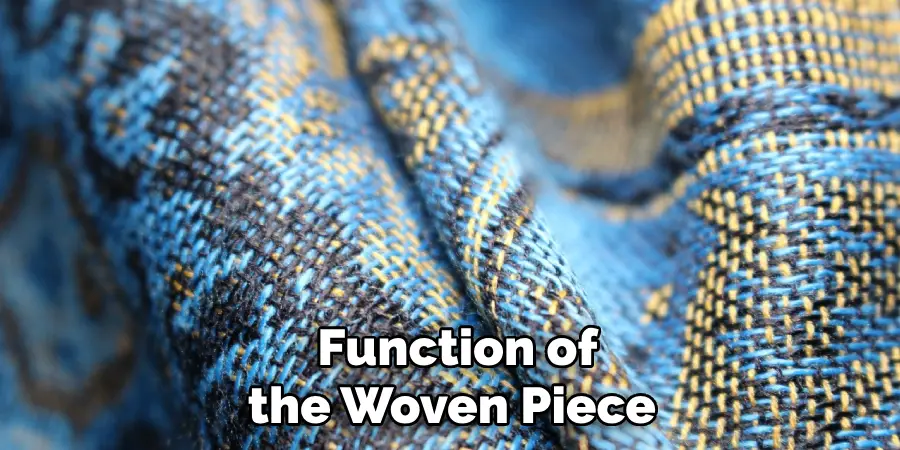
Additionally, while the plain weave is the simplest technique, it can still produce beautiful and intricate designs when using different colored yarns or varying the tension of the weave. So, while it may be considered the simplest, plain weave is far from boring or essential. It’s a versatile and fundamental weaving technique that has stood the test of time.
Conclusion
In conclusion, how to weave a chair seat fabric strips is the perfect way to add a unique touch to your furniture and showcase your creativity. Not only does it provide a budget-friendly option for updating old chairs, but it also allows you to personalize them in ways that store-bought covers cannot.
With suitable materials and techniques, you can create beautiful and durable chair seats that will enhance the aesthetic of any room. So don’t be afraid to try different patterns and color combinations; don’t give up if you make mistakes. Remember, crafting is just as important as a result.
So slow down, enjoy the rhythmic motions of weaving, and take pride in knowing that you have transformed a simple piece of furniture into a work of art.

